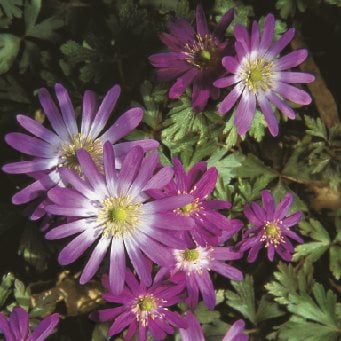Deer-Proof Bulbs
Keep Bambi at bay with these deer-resistant bulbsWhether you plan to attract wildlife to the garden or not, Bambi and his relatives may come to dine. The various repellents and fencing options are not guaranteed solutions. I find it is easier to grow plants deer generally don’t eat. Here are bulbs that grow just fine on my unfenced 9 acres in western New Jersey, where deer look in the kitchen window, as well as other deer-proof bulbs suitable for gardeners in other states.
Random bulb genera that deer ignore include Canna, Oxalis and Cyclamen. Many more deer-proof bulbs may be found in the Amaryllis family. Poisonous, and seemingly immune to browsing by deer, these include all daffodils (Narcissus), all snowdrops (Galanthus) and all Leucojum, including both spring and summer snowflakes. All three genera thrive in Maine, Massachusetts, Minnesota and Michigan, as well as states farther south.
Gardeners in California and similar Mediterranean regions can grow Amaryllis belladona, the true amaryllis, commonly known as naked lady. Other tender Amaryllis family members include Crinum, Hippeastrum, Nerine, Zephyranthes and another naked lady, also known as surprise lily or magic lily, Lycoris species and cultivars, popular with gardeners in North and South Carolina, Tennessee, Mississippi and any other Zone 9 to 11 region you care to name.
Aroids (plants in the Araceae or Arum family) contain oxalic acid crystals in all parts of the plants. Accordingly, all jack-in-the-pulpit (Arisaema species), whether native North American or exotic Asian, are distasteful to deer. So are caladium, seasonal plants for cooler climates and permanent features in Florida gardens. Deer in the Gulf states, Florida and the Texas Gulf region also decline to dine on calla lily, Calla and Zantedeschia species and cultivars.
Perhaps because many of the Ranunculus family are poisonous, all bulbs in this family are ignored in my garden. Winter aconite (Eranthis hyemalis) is disregarded, as are anemones such as spring-blooming Grecian windflower (Anemone blanda) and the woodland A. nemorosa.
Though Lily family bulbs such as lilies and tulips are popular salad bar favorites for deer, there are a few bulbs in this family that they ignore. These include all the ornamental onions (Allium species and cultivars) every Camassia I ever planted; and the pretty little blue-flowered glory of the snow (Chionodoxa). Spring-flowering squills (Scilla) are also unharmed. Every fritillaria, from the stately but skunk-smelling crown imperial (Fritillaria imperialis) to the charming checkered bell flowers of Guinea hen flower (F. meleagris), are also left alone. Grape hyacinths (Muscari species and cultivars) grow and flower unhindered. Confusingly called naked lady (which seems a popular name) or fall crocus (which it is not), the poisonous fall-flowering Colchicum remains unmolested. Though hyacinths do poorly in subsequent years, deer don’t eat them and so cannot be the culprits for their decline in my garden. Deer will, however, occasionally chew the tips off leaves of wood hyacinth (Hyacinthoides hispanica).
So even if tulips are devoured and dahlias gobbled down, take heart. There are lumpy underground treasures that you can plant with confidence and enjoy.
RELATED:
Bulbs for Your Garden
A Modern Garden in Deer Country
Deer-Resistant Plants
Warm-Climate Flower Bulbs: Choices & Design Tips
Bulbs 101: Planting and Storing Flower Bulbs








